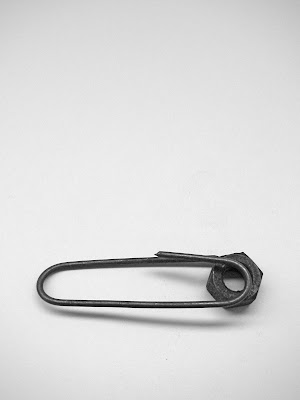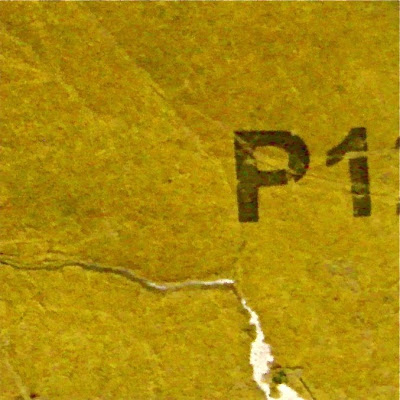This week, CLOG is very proud to feature
Brydie Dyson, one of COUNTER's stockists and one of Melbourne's nicest people. Using fibre art and paper as her main medium, Brydie tucks, folds and sews her chosen material into some of the loveliest
objet d'art we've ever seen.
When she's not busy crafting away, Brydie manages a beautiful shop in Olinda called
MINE, which according to her is "ethical and creative space that harbours the passions of crafters, artists and designers who create well-made children's goods."
Sounds divine!
Without further ado, please read away and be sure to check out
Brydie's blog - it's a really good read!

Paper is definitely a wonderful medium to work with. What drew you to the material initially, and what do you like about it the most?
Paper is so lovely to work with! I have always been drawn to utilizing paper over another medium because of its accessibility and its affordability. Whenever I’d feel like creating I’d pool my surrounding resources together and make. It usually happened to be with paper.
Paper can be a really adaptable medium. I can create some amazing textural depths and sculpted variances by simple and workable methods. It’s easily folded, cut, and torn.
However, sometimes, no matter what I try to create, the paper dictates the direction of its form- I find this a great challenge to work with and try to pre-empt its development and build around it. I feel like I am my paper’s apprentice.
Using second-hand materials allows me to work in a more sustainable and eco-friendly manner. I would like to further this and explore options on how I could continue to reduce my footprint on the environment through my craft.
I use a lot of old books. The foxing (discolouring) of the pages is a beautiful counterbalance to the imprinted black text and images. When you open an old book so many things can transport you through someone else’s world. The smell of the pages, the discarded bookmarks, the personal scribes of the previous book-owner; all this is part of the joy of the process.
At the same time, it is quite slow and repetitive work. For a single paper urchin (pictured below) to reach completion it goes through 2.5 hours of the making process.
The fragility of the medium and the wearer’s relationship with the jewellery is something I play with in the conceptual side to my craft. The work challenges the social conventions of preserving art objects by suggesting that possessions can evolve over time and command their own aesthetics, becoming even more beautiful and well crafted by their own accord through the natural wear and tear of the object.
 Could you please tell us about your other life as manager of MINE? It sounds like a wonderful shop with an especially great initiative!
Could you please tell us about your other life as manager of MINE? It sounds like a wonderful shop with an especially great initiative!MINE is fantastic! Two of my wonderful and creative friends, Victoria Clarke and Carolyn Deutsher initiated MINE Kids in Olinda last July in the Dandenong Ranges, and asked me to be the manager for the space. The two Hills Mums were inspired by the local artisans who were making amazing children’s goods and working in ethical and sustainable ways, using natural fibres and organic processes.
We support the crafts of local and Australian designers and artists who make toys, furniture, clothing, bedding and art-objects for children through a retail space and our exhibition window. In our exhibition space we have represented the work of Gracia Haby and Louise Jennison, Elaine Haby (a.k.a. Thelma), and Vanessa Oter. Sometimes we hold events for kids. The last was a puppet show, performed by Penelope Arvanitakis with handmade finger puppets, an accompanying zine, and a puppet stage… and free popcorn!
We’ve got a call out at the moment to makers of children’s goods who’d like to exhibit in our window space for the later part of 2009 to mid-2010. They can
email me for more information.
 Have any artists or fellow makers been a great inspiration for you?
Have any artists or fellow makers been a great inspiration for you?
I admire the work of a Finnish paper jeweller, Janna Syvanoja. One day I dream of contacting her and being her mentee.
Emma van Leest, Kylie Stillman, Peter Callesan and Chris Natrop are amazing paper artists. They are masters of their craft. I highly recommend you check out their work if you haven’t done so before.
Kei Takemura is a Japanese artist who I have had the pleasure to be in postal contact with. She embroiders murals of rooms and forms onto silk, and has initiated mending broken vessels through wrapping and sewing. Her embroidery is very texturally complex, and utterly beautiful.
I have been a keen follower of
Gracia and Louise’s collaborative work for a while now. I especially love their zines and artists books. Pene Durston is an incredibly skilled advocate for the DIY culture and cottage industries, and Stewart Russell and the Spacecraft team create amazing design products and art collaborations with their screenprinting.
Are there any enviable craft skills that you’d like to learn? YES! Printmaking, bookbinding, moulding and firing with clay and porcelain, glass blowing, knitting with patterns. crochet, sewing with patterns…Oh, the list goes on!
 What gets you in the mood to create?
What gets you in the mood to create?Nothing fuels my work more strongly than a deadline! This is followed by guilt of neglect, which is then followed by seeing through with a spontaneous idea.
My amazing and talented family and friends and my gorgeous partner are all fantastic impetus for getting creative.
Going and seeing a performance or exhibition, reading a book, or remembering to take the time to admire the beauty of our many varying landscapes are all very good mood-setters for a little creativity, also.
What is your most favourite thing in the world right now?
Right now? Big woollen scarves, pots of tea, line-drawing (both the contemporary and not so recent), having a stem of Banksia ashbyi on my study desk, Aesop’s Tuberose lip heal, and most importantly, cuddles.
And finally, what would your dream project entail?Within the next five years I hope to establish my own business –
The Fur of the Sloth – artist book space. This business is to function as a semi-government supported gallery, substantial library, resource space, studio workshop and educational seminar house for primary/secondary/tertiary students, hobbyists and professionals interested in researching or undertaking skills within the specialised area of multiples and artist-book making and appreciation. The space will also contain a retail section dedicated to artist-books, as well as the more commonly collected zine made by the strong community of Australian artist-book makers, as well as from the international arena.
I envision within the space, a very petite coffee stand and drinking corner, called
make&take. For me, reading and coffee go almost always hand in hand – and Melbourne is obsessed by the café!
There will be staff members, artists and curious customers that will have illustrated onto sheets of waxed paper and learned how to turn them into a cup. These cups are what the customer’s coffee will come in!
My ambition is for this specialist business to hold the most substantial collection of artist-books within Australia, and run as a working affiliate with peer institutions such as the State Library of Victoria.











 Looking forward to seeing you tomorrow evening for a drink at Mailbox 141, located at the entrance of 141-143 Flinders Lane (where The Narrows is).
Looking forward to seeing you tomorrow evening for a drink at Mailbox 141, located at the entrance of 141-143 Flinders Lane (where The Narrows is).
 This week meet Simon Lloyd, who recently showed his exhibition Gleaning Potential in Gallery 1 here at Craft Victoria. We hope you managed to catch this marvellous show consisting of familiar objects re-made with not-so-familiar materials (paper spoons anyone?), a block of pitch attached to the ceiling which unfortunately fell victim to gravity and of course, the wonderful replica of Simon's studio.
This week meet Simon Lloyd, who recently showed his exhibition Gleaning Potential in Gallery 1 here at Craft Victoria. We hope you managed to catch this marvellous show consisting of familiar objects re-made with not-so-familiar materials (paper spoons anyone?), a block of pitch attached to the ceiling which unfortunately fell victim to gravity and of course, the wonderful replica of Simon's studio.



















+small.jpg)


+small.jpg)
+small.jpg)

+small.jpg)
+small.jpg)









